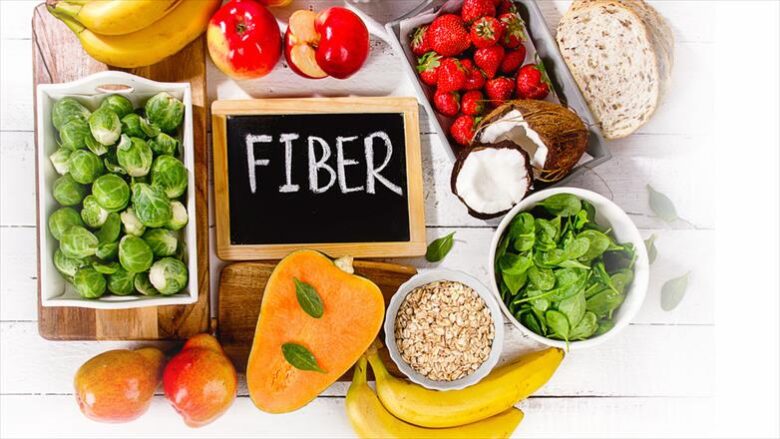When people talk about nutrition, they often mention protein, vitamins, and minerals, but fiber intake is just as important for overall health. Fiber is crucial, but many people don’t get enough of it daily. This can lead to stomach problems, heart problems, and even long-term illnesses. The good news: adding more fiber to your diet is easy and can provide both immediate and long-term benefits. This article explains the different types of fiber, their importance, and how you can easily incorporate them into your daily diet.
What is fiber and why is it important?
Food fiber is a type of protein that the body cannot completely break down. Unlike sugars and starches, fiber remains intact in the digestive system for most of its lifespan and helps the body perform many functions. Soluble fiber and insoluble fiber are the two main types. They support health in different ways, but both are important.
Fiber that dissolves in water turns into a gel-like substance in the stomach. It slows digestion, regulates blood sugar levels, and lowers cholesterol. Foods rich in this type of fiber include oats, beans, apples, and citrus fruits.
Insoluble fiber, on the other hand, adds bulk to stool, helping food move through the digestive system more quickly. This contributes to a healthy digestive system and prevents constipation. Vegetables, nuts, seeds, and whole grains all contain significant amounts of insoluble fiber.
To maintain a healthy, balanced, and long-lasting diet, you need to understand both types of fiber.
Why Fiber is Good for You
Fiber is sometimes called “nature’s broom” for its ability to cleanse the digestive system. But the benefits of fiber extend beyond just digestion. Here are some key ways fiber benefits the body:
It Aids in Healthy Digestion
Fiber keeps digestion smooth by adding bulk to stool and preventing constipation. It also helps maintain healthy gut flora, as beneficial bacteria consume certain types of fiber and produce chemicals that boost the immune system and reduce inflammation.
It helps regulate blood sugar levels
Fiber is a great help for people with diabetes or those trying to maintain stable energy levels. Soluble fiber slows down sugar intake and prevents rapid fluctuations in blood sugar.
It’s good for your heart
Consuming soluble fiber can lower LDL cholesterol (low-density lipoprotein), the “bad” cholesterol. This can reduce your risk of cardiovascular disease. Fiber-rich foods can also help lower blood pressure and improve circulation.
Helps you manage your weight
Fiber-rich foods generally make you feel fuller, which helps prevent overeating. Fiber slows digestion, so you feel fuller longer and are less likely to reach for unhealthy foods.
Reduces your risk of chronic diseases
Researchers have found that people who consume sufficient fiber have a lower risk of type 2 diabetes, cardiovascular disease, and certain types of cancer. Fiber is therefore an important part of maintaining good health.
How much fiber should you consume daily?
Adult women should consume about 25 grams of fiber daily, and men about 38 grams. Unfortunately, most people only consume 15-18 grams of fiber per day, which is well below the recommended daily amount. Because of this deficiency, it’s important to remember to add fiber to your daily meals and snacks.
How to get more fiber easily?
The good news is that you don’t have to make drastic changes to increase your fiber intake. Simply make small, regular changes to meet your daily needs and reap the benefits.
Start your day right with whole grains
Replace refined carbohydrates with whole grains. For a healthy breakfast, choose whole-wheat bread, oatmeal, or whole-grain cereal. For dinner, try quinoa or brown rice instead of white rice or pasta. Both make delicious side dishes.
Snack on fruits and vegetables
Provide fresh fruits and vegetables as snacks. Apples, pears, carrots, and celery are fiber-rich and easy-to-carry options. Whenever possible, eat fruits and vegetables with the skin on for extra fiber.
Include beans regularly
Beans, lentils, and chickpeas are excellent sources of fiber. Adding them to soups, salads, or stews creates a filling and healthy meal.
Drinking enough water makes your digestion easier.
Avoid the following when taking fiber supplements:
Fiber is good for you, but too much at once can cause stomach pain or bloating. Gradually increase the amount of fiber in your diet over a few weeks to give your body time to adjust. Another mistake is not drinking enough water. A high-fiber diet can worsen constipation if you’re not properly hydrated. Finally, a balanced intake is important. For optimal health benefits, try to consume both soluble and insoluble fiber.
Frequently Asked Questions about Fiber
Can fiber products replace high-fiber foods?
A1: If you struggle to get enough fiber every day, fiber products can help, but whole foods are always a better choice. They provide additional nutrients, vitamins, and health benefits that pills can’t fully match.
Q2: Can consuming too much fiber be harmful?
A2: Consuming too much fiber, especially in a short period, can cause stomach pain, diarrhea, or bloating. Stick to the recommended daily amount and gradually increase it as needed.
Q3: What are the best high-fiber foods for picky eaters?
A3: Fruits, vegetables, and seeds can be added to smoothies to make them healthier. You can also eat fruit snacks, whole-wheat bread, or cooked beans.
Q4: Does cooking vegetables reduce their fiber content?
A4: Cooking can slightly reduce the fiber content of foods, but the fiber content remains largely the same. Steaming and roasting are gentle cooking methods that help preserve nutrients.
Q5: How long does it take to feel better after eating more fiber?
A5: Many people notice relief from their stomach problems within a few days to a few weeks. For long-term benefits, such as lowering cholesterol or managing weight, you may need to continue taking supplements for several months.
Summary
Fiber is rarely discussed, but it truly is one of the best foods for overall health. The benefits are clear: it promotes digestion, regulates blood sugar levels, and reduces the risk of chronic diseases. Fortunately, you don’t have to completely overhaul your lifestyle to increase your fiber intake. Simple changes, like choosing whole grains, eating more fruits and vegetables, and adding beans to your diet, can make a big difference. Consciously consuming fiber will lead to more energy, better digestion, and improved health in the long run.




